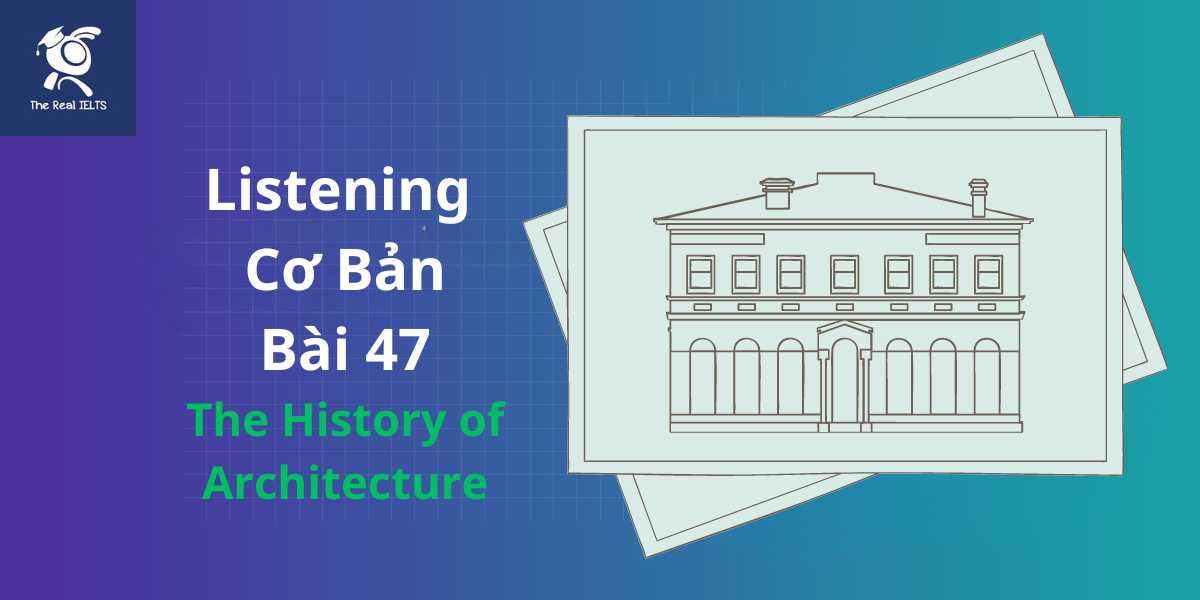Bài Listening nói về lịch sử ngành Kiến Trúc. Đây lại là một bài sẽ có nhiều thuật ngữ tiếng Anh chuyên ngành. Các bạn hay nghe đi nghe lại để luyện tập và trả lời câu hỏi.
Bài Listening
Questions
- What were the pyramids of ancient Egypt used for?
- Name the three classical orders developed by the Greeks.
- What architectural innovations did the Romans introduce?
- Which style is characterized by thick walls and round arches?
- What are some key features of Gothic architecture mentioned in the lecture?
- During which period did architects like Filippo Brunelleschi and Andrea Palladio work?
- Name two architects from the modern era who revolutionized the field of architecture.
- What is becoming increasingly important in future architectural designs?
- Mention one of the materials that allowed for the creation of skyscrapers.
- What is the main focus of sustainable architecture?
Answers
- The pyramids of ancient Egypt were used as tombs for pharaohs.
- The three classical orders developed by the Greeks are Doric, Ionic, and Corinthian.
- The Romans introduced innovations such as the arch, the vault, and concrete.
- The Romanesque style is characterized by thick walls and round arches.
- Key features of Gothic architecture include pointed arches, ribbed vaults, and flying buttresses.
- Filippo Brunelleschi and Andrea Palladio worked during the Renaissance period.
- Two architects from the modern era who revolutionized the field of architecture are Frank Lloyd Wright and Le Corbusier.
- Sustainable architecture is becoming increasingly important in future architectural designs.
- Steel is one of the materials that allowed for the creation of skyscrapers.
- The main focus of sustainable architecture is to minimize environmental impact.
Audio Transcript
“Good afternoon, everyone. Today’s lecture will be about the fascinating history of architecture, tracing its evolution from ancient times to the modern era. We’ll begin by exploring the architectural wonders of ancient civilizations.
The ancient Egyptians were among the earliest to develop monumental architecture. Their pyramids, such as the Great Pyramid of Giza, were not only tombs for pharaohs but also a demonstration of their engineering prowess and spiritual beliefs.
Moving forward in time, the Greeks made significant contributions to architectural design, particularly through the development of the three classical orders: Doric, Ionic, and Corinthian. These styles have profoundly influenced Western architecture.
The Romans, on the other hand, were masters of engineering and construction. They borrowed heavily from Greek designs but also introduced innovations such as the arch, the vault, and concrete. One of their most iconic structures is the Colosseum, which exemplifies their architectural and engineering skills.
During the medieval period, architecture was dominated by religious buildings. The Romanesque style, characterized by thick walls and round arches, evolved into the Gothic style, known for its pointed arches, ribbed vaults, and flying buttresses. The Notre-Dame Cathedral in Paris is a prime example of Gothic architecture.
The Renaissance brought a revival of classical learning and a renewed interest in Roman and Greek architecture. Architects like Filippo Brunelleschi and Andrea Palladio sought to bring symmetry, proportion, and geometry back into design, resulting in structures that emphasized harmony and clarity.
In the modern era, architecture has seen a dramatic shift with the advent of new materials and technologies. The development of steel and reinforced concrete allowed for the creation of skyscrapers and expansive urban infrastructures. Architects like Frank Lloyd Wright and Le Corbusier revolutionized the field with their innovative designs that focused on functionality as well as aesthetics.
As we look to the future, sustainable architecture is becoming increasingly important. Architects are now challenged to create buildings that not only meet the needs of their occupants but also minimize environmental impact. This involves using eco-friendly materials, incorporating renewable energy sources, and designing for energy efficiency.
That concludes our brief overview of the history of architecture. I hope this has given you a better understanding of how architectural styles and techniques have evolved over the centuries. Thank you for listening.”
Học lại bài cũ: Bài tập Listening 46: Organic Farming and Sustainability.















